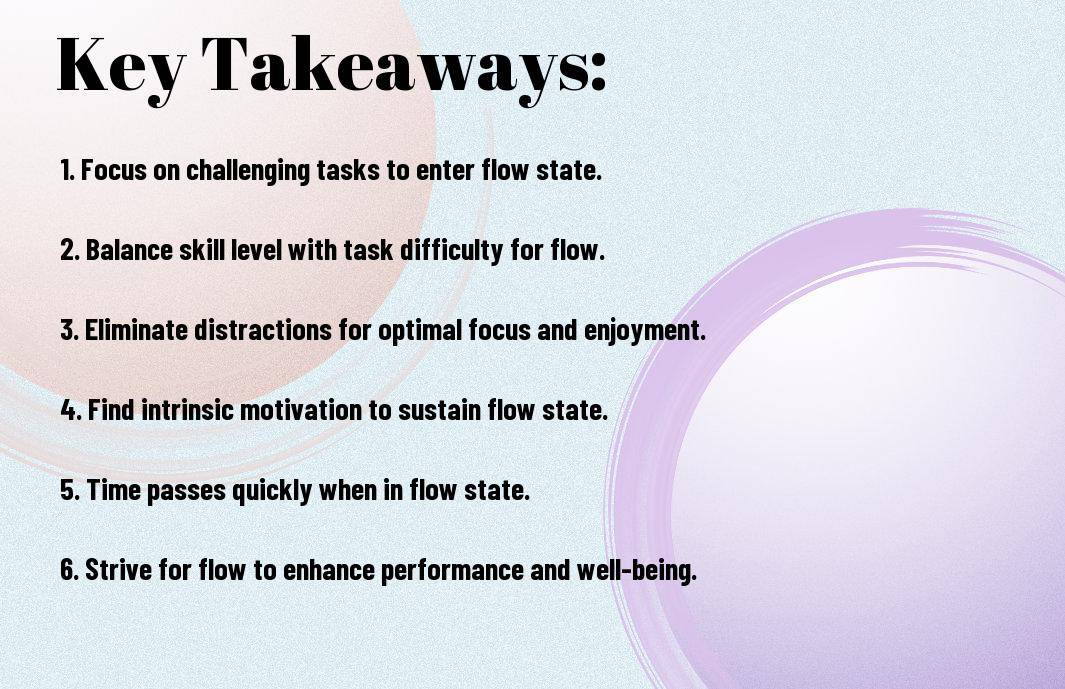Flow State, a concept introduced by psychologist Mihaly Csikszentmihalyi, is a state of mind where individuals experience optimal focus and enjoyment while engaging in an activity. This state, often referred to as being “in the zone,” is characterized by a complete absorption in the task at hand, leading to a heightened sense of productivity and fulfillment.
By understanding the key components of Flow State and implementing Csikszentmihalyi’s method, individuals can unlock their full potential and experience increased performance in various aspects of their lives. This blog post will investigate into the intricacies of Flow State, exploring how this concept can revolutionize the way we work, play, and live.
Key Takeaways:
- Definition of Flow State: Flow state, coined by Csikszentmihalyi, is an optimal mental state where an individual is fully immersed in a task, feeling focused, energized, and deeply enjoying the process.
- Key Elements of Flow: Clear goals, immediate feedback, balance between skill and challenge, complete concentration, sense of control, losing self-consciousness, and transformation of time are imperative components of achieving flow.
- Benefits of Flow State: Increased productivity, heightened creativity, enhanced learning, improved performance, a sense of fulfillment, and a boost in overall well-being are some of the advantages of experiencing flow state.
- How to Enter Flow State: Engaging in activities that align with one’s skills, setting clear goals, eliminating distractions, focusing on the present moment, and finding a balance between boredom and anxiety can help induce flow state.
- Strategies to Sustain Flow: Maintaining a state of deep focus, challenging oneself with progressively difficult tasks, seeking feedback to adjust performance, embracing the process rather than the outcome, and allowing for breaks to refresh the mind are key tactics to sustain flow.
- Applications of Flow State: Flow can be experienced in various domains such as work, sports, arts, hobbies, and daily activities, leading to improved performance and overall enjoyment in different aspects of life.
- Cultivating Flow State: By practicing mindfulness, setting specific goals, building skills gradually, engaging in activities that match one’s interests, and finding passion in what one does, individuals can cultivate flow state as a pathway to optimal focus and enjoyment.

Defining Flow State
Assuming you’ve ever been completely absorbed in a task, losing track of time and feeling a sense of deep enjoyment and fulfillment, you might have experienced what psychologist Mihaly Csikszentmihalyi calls “flow state.” This mental state of operation involves complete immersion and focus in an activity, where one’s concentration is fully directed towards the task at hand.
The Psychological Aspects of Flow
Flow state is characterized by a balance between the perceived challenges of the activity and one’s perceived skills. When the challenge level matches the individual’s abilities, a state of flow is more likely to occur. Csikszentmihalyi suggests that to achieve flow, it is crucial to set clear goals, receive immediate feedback, and maintain a deep focus on the task. Additionally, the sense of control and a loss of self-consciousness are common psychological aspects experienced during flow.
Characteristics of Flow
Psychological studies have identified several key characteristics of flow state. These include intense concentration on the task at hand, a merging of action and awareness, a loss of reflective self-consciousness, a distorted sense of time, and a feeling of intrinsic reward. In essence, flow state represents a state of optimal experience where individuals are fully engaged and enjoying the process of the activity.

The Path to Achieving Flow State
Now, in the journey towards experiencing the state of flow, it is crucial to understand the path to achieving optimal focus and enjoyment. This state, first introduced by psychologist Mihaly Csikszentmihalyi, refers to a mental state of operation where a person is fully immersed in a feeling of energized focus, full involvement, and enjoyment in the process of the activity.
Preconditions for Flow State
One of the preconditions for entering a state of flow is setting clear goals that are achievable and provide a sense of progress. Additionally, having immediate feedback on performance is important to adjust and maintain focus throughout the activity. Furthermore, a balance between challenge and skills is necessary to prevent boredom or anxiety and maintain engagement.
Activities That Facilitate Flow
That said, there are specific activities that can facilitate the experience of flow, such as playing a musical instrument, engaging in sports, painting, coding, or even gardening. These activities typically require skill and present a challenge, but are also enjoyable and rewarding. The key is to find activities that you are passionate about and that align with your skills and interests.
Another factor that can help facilitate flow is the element of unpredictability or novelty in the task. This can keep the mind engaged and prevent boredom, leading to a deeper sense of immersion in the activity.
It is important to note that achieving flow is not always easy and may require practice and patience. Engaging in activities that bring you joy and challenge you can help pave the way towards experiencing this optimal state of focus and enjoyment.

The Role of Goals and Feedback
Setting Clear Goals
Keep in mind that setting clear and achievable goals is necessary in entering the flow state. Goals provide a sense of direction and purpose, guiding your actions towards a specific outcome. When goals are clearly defined, it becomes easier to focus your attention and mobilize your efforts effectively. Additionally, clear goals can help you track your progress and stay motivated throughout the task.
Immediate Feedback and Flow
An important aspect of achieving flow is to receive immediate feedback on your actions. This feedback loop allows you to adjust your performance in real-time, making the necessary corrections to stay on track towards your goals. Immediate feedback not only enhances your focus but also deepens the level of engagement in the task at hand. It creates a sense of challenge-skill balance, keeping you in the flow state.
Understanding the role of goals and feedback is crucial in harnessing the power of the flow state. By setting clear and meaningful goals, you give yourself a roadmap to follow, while immediate feedback keeps you on the right path. These elements work together to enhance your focus, enjoyment, and overall performance, leading to a more fulfilling and productive experience.
The Impact of Flow on Productivity and Enjoyment
Your productivity and enjoyment can greatly benefit from entering the flow state, a concept introduced by psychologist Mihaly Csikszentmihalyi. When in a state of flow, you experience optimal focus and enjoyment in the task at hand, leading to heightened performance levels and a sense of fulfillment.
Enhancing Work and Creativity
For individuals looking to enhance their work performance and creativity, achieving flow is key. By immersing yourself in a task that matches your skill level and challenges you just enough, you can enter a state of flow where time seems to fly by, distractions fade away, and you perform at your best. This heightened focus can lead to increased productivity, creativity, and a sense of accomplishment in your work.
Flow in Everyday Life and Leisure
Enjoyment in everyday life and leisure activities can also be greatly enhanced by tapping into the flow state. Whether you’re engaging in a hobby, sports, or simply enjoying a leisurely activity, entering flow can make the experience more enjoyable and rewarding. This state of full immersion and focus can turn mundane activities into deeply satisfying experiences.
This state of flow can lead to a greater sense of fulfillment and happiness in your daily life, as you engage in activities that bring you joy and satisfaction. By cultivating the conditions for flow in both work and leisure, you can unlock your full potential and experience a more fulfilling and enjoyable life overall.
Mastering Flow in Practice
For individuals looking to achieve optimal focus and enjoyment in their activities, mastering the flow state is imperative. By following Mihaly Csikszentmihalyi’s methods, one can learn to enter the flow state more consistently and reap its benefits. In this chapter, we will research into practical techniques that can help you master the flow state in your everyday life.
Mindfulness Techniques to Foster Flow
Mastering the flow state requires a keen awareness of one’s thoughts and actions. Mindfulness techniques can help individuals cultivate this awareness and stay present in the moment. Techniques such as deep breathing exercises, meditation, and body scans can all help individuals quiet their minds and focus on the task at hand. By incorporating these practices into your daily routine, you can train your mind to enter the flow state more easily and sustain it for longer periods.
Maintaining Flow in Challenging Environments
Practice is imperative when it comes to maintaining flow in challenging environments. It is natural to encounter obstacles and distractions that can disrupt your focus and pull you out of the flow state. However, by practicing techniques such as visualization, positive self-talk, and task prioritization, you can overcome these challenges and stay immersed in the present moment. Consistent practice is key to building resilience and maintaining flow even in the face of difficulty.
A common challenge individuals face when trying to maintain flow in challenging environments is dealing with stress and pressure. Learning how to manage stress effectively and stay calm under pressure is crucial for staying in the flow state. By practicing mindfulness and self-care strategies, individuals can build their resilience and navigate through challenging situations with greater ease.

The Role of Flow in Personal Development
Flow and the Growth of the Self
Many individuals seek personal development as a means to cultivate a deeper understanding of themselves and to enhance their overall well-being. Through the concept of flow, as introduced by Mihaly Csikszentmihalyi, individuals can enter a state of optimal focus and enjoyment that promotes growth on a personal level. Flow allows individuals to challenge themselves and engage in activities that are aligned with their skills, fostering a sense of mastery and accomplishment.
Long-Term Benefits of Flow Experiences
For individuals committed to personal development, engaging in flow experiences can lead to lasting benefits that extend beyond the immediate enjoyment derived from the activity. Personal growth, increased self-confidence, and a heightened sense of fulfillment are just a few of the long-term advantages that individuals may experience through regular immersion in flow-inducing activities.
To fully harness the power of flow for personal development, individuals must be consistent in seeking out activities that challenge their skills while providing intrinsic motivation. Embracing flow as a way to enhance personal growth can lead to transformative experiences that shape one’s sense of self and overall well-being.
To wrap up
Drawing together the principles of Mihaly Csikszentmihalyi’s Flow State method, we can see how achieving optimal focus and enjoyment is not only possible but also highly beneficial for personal well-being and productivity. By understanding the conditions and characteristics of flow, individuals can proactively create environments and tasks that foster this state of peak performance and satisfaction in their lives. Those who master the art of flow state can expect increased creativity, heightened concentration, and a profound sense of fulfillment in their daily activities.
For further insights on how to tap into your flow state, you can explore the article What is flow state? Find your flow with these 6 steps for practical tips and guidance on integrating flow principles into your routine. Embracing the flow state philosophy can set you on a path towards greater happiness and success by maximizing your potential and experiencing deep satisfaction in whatever you choose to pursue.
FAQ
Q: What is Flow State?
A: Flow state, as proposed by Mihaly Csikszentmihalyi, is a mental state where an individual is fully immersed in an activity, feeling energized focus, full involvement, and enjoyment in the process.
Q: What are the key characteristics of Flow State?
A: The key characteristics of Flow State include intense focus, a merging of action and awareness, a loss of self-consciousness, a sense of control, distorted sense of time, and an intrinsic motivation to continue the activity.
Q: How can one achieve Flow State?
A: To achieve Flow State, one needs to engage in activities that are challenging yet achievable, set clear goals, receive immediate feedback, eliminate distractions, and focus on the present moment.
Q: What are the benefits of Flow State?
A: The benefits of Flow State include increased productivity, enhanced creativity, improved performance, a sense of fulfillment, and overall well-being.
Q: How can Flow State be applied in daily life?
A: Flow State can be applied in daily life by identifying activities that bring enjoyment and challenge, creating a conducive environment for focus, setting specific goals, and consciously immersing oneself in the task at hand.
Q: Are there any risks associated with Flow State?
A: While Flow State is generally beneficial, there can be risks such as neglecting basic needs, losing track of time, or becoming too reliant on the emotional highs associated with the state.
Q: Can anyone achieve Flow State?
A: Yes, anyone has the potential to achieve Flow State by engaging in activities they are passionate about, fine-tuning their skills, and cultivating a mindset of focused immersion and enjoyment.
Expand Your Knowledge
Life Hacking – Secrets to Enhanced Brain Function
The Science of Concentration in The Art of Focus
Unlocking the Zeigarnik Effect: How Bluma Zeigarnik’s Open Tasks Can Skyrocket Your Motivation
Pomodoro Technique – Francesco Cirillo’s Method to Improve Focus and Manage Time
80/20 Rule (Pareto Principle) – Vilfredo Pareto’s Technique to Focus on High-Yield Tasks



